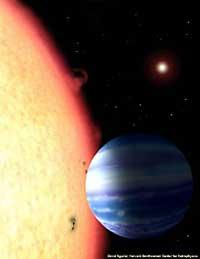A planet at 5,000 light years
The new exoplanet has been called ogle-56b by the technique used in searches. They are the initials of the OGLE Optical Gravitational Lensing Experimental project, which analyzes the light of hundreds of stars from Chile. Astronomers wait for the intensity of light to come down to conclude that some planet has passed before the star.

Currently there are two techniques of searching for planets outside the solar system. Both indirect, since exoplanets cannot be seen live and both based on the light of the star. The traditional method is the Doppler technique, based on the vibration of light. Astronomers follow the tremor of light to detect abnormal vibrations that can be caused by the gravitational force of the planet.
In a few years a hundred exoplanets have been detected spying vibration, technique that does not serve to perform searches to more than 160 light years. In addition, you have to use giant telescopes and a lot of time.
The other technique, the most recent, is to wait for the planet to pass in front of the star. The planet covers the light of the star as it passes by and astronomers measure the drop in intensity. Approximately a small eclipse occurs. This technique serves to detect planets much farther away and provides more data on the planet from the beginning, but so far it has only awakened hope. In 2001 the passage of an exoplanet was detected, but it was known. Otherwise, all have been failures. Therefore, the exoplanet ogle-56b is special for astronomers.
A planet stuck to the star
It is estimated that the planet ogle-56b is 2.6 times higher than Jupiter and has a density equivalent to Saturn. Astronomers believe that the temperature of the atmosphere is about 2,300ºC, so only iron clouds are produced. It is 5,000 light-years from us and very close to its star, 14 times closer than the Sun. It has twenty-nine hours to complete an orbit.
To date no planet has been detected orbiting so close to a star, but it has not been the most exciting for astronomers, but how it has been found. Some have announced that the first success of the new technique will soon bring many others.
Buletina
Bidali zure helbide elektronikoa eta jaso asteroko buletina zure sarrera-ontzian











